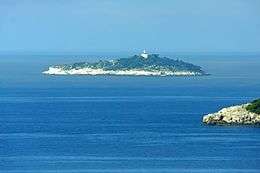Sveti Andrija (Dubrovnik)
 | |
| Geography | |
|---|---|
| Location | Adriatic sea |
| Coordinates | 42°38′45″N 17°57′5″E / 42.64583°N 17.95139°ECoordinates: 42°38′45″N 17°57′5″E / 42.64583°N 17.95139°E |
| Archipelago | Elaphiti Islands |
| Area | 0.053 km2 (0.020 sq mi) |
| Highest point | 57 |
| Administration | |
|
Croatia | |
| County | Dubrovnik-Neretva |
 Sveti Andrija Lighthouse Croatia | |
| Location | Sveti Andrija Island, Croatia |
|---|---|
| Coordinates | 42°38′47″N 17°57′05″E / 42.646525°N 17.951387°E |
| Year first constructed | 1873 |
| Construction | stone tower |
| Tower shape | cylindrical tower with balcony and lantern rising from a 2-story keeper’s house |
| Markings / pattern | unpainted white stone tower, white lantern |
| Height | 17 metres (56 ft) |
| Focal height | 69 metres (226 ft) |
| Light source | solar power |
| Range |
main: 24 nautical miles (44 km; 28 mi) reserve: 12 nautical miles (22 km; 14 mi)[1] |
| Characteristic | Fl W 15s. |
| Admiralty number | E3590 |
| NGA number | 14024 |
| ARLHS number | CRO-001[2] |
Sveti Andrija (Croatian for Saint Andrew) is an island in the Croatian part of the Adriatic Sea. It is part of Elaphiti Islands archipelago, Dalmatia and is situated 6 nautical miles (11 km) from Dubrovnik, 3 nautical miles (6 km) from Koločep, 2 nautical miles (4 km) from Lopud and 4 nautical miles (7 km) from Šipan.[3] The island is 475 metres (1,558 feet) long, and its maximal width is 1,300 metres (4,300 feet), length of shore is 1,130 m (3,710 ft). Total area of the island is 53,757 square metres (578,640 square feet), and height is 57 m (187 ft).[4]
The shores of the island are rocky and inhospitable. The western part of the island is covered with pine forest and various Mediterranean growth. Vegetation on the rest of the island is low lying, mainly bushes. Due to numerous amount of birds, the island was declared an ornithological reserve.
History
The patrician family Crijević from Dubrovnik built Benedictine monastery on the island in the 15th century. The monastery was remote and isolated and during time it was used for various purposes. For some time, it was used as quarantine for inhabitants of island of Lopud. The monastery was destroyed during an earthquake in 1667.
Lighthouse
During 1873 a lighthouse was built on the island, financed by the Austro-Hungarian government. A two-storey house was built, with a masonry tower in the centre. The building has area of 210 square metres (2,300 square feet), and a lantern room with a gallery is fitted at the top of the 17 metres (56 ft) tower. The optic is a clamshell Fresnel lens. At a height of 69 metres (226 feet) above sea level, the light is visible from a distance of 24 nautical miles (44 kilometres; 28 miles), making it one of strongest lights in Adriatic Sea.[5][6]
Famous people on Sveti Andrija
In the 16th century, Mavro Vetranović Čavčić, a famous poet from Dubrovnik lived on the island as a monk. About this time on the island he wrote in his poem "Remeta". Ludovik Crijević Tuberon, a historian from Dubrovnik lived there at the end of 15th century.
Legend connected with Sveti Andrija
A young girl, Mare, lived with three brothers on island of Lopud. Her friend Cvijeta had a brother Niko who was very interested in Mare. The brothers were fishing one night and from the stormy sea they rescued a shipwreck victim, the young patrician "Ivan". He was from an influential noble family from Dubrovnik. He was sick and Mare nursed him. They fell in love, but their love was forbidden because they came from different classes. Ivan tried his best to obtain permission from his father but without any success. Disappointed, he quit ordinarry life and become a monk on the island of Sveti Andrija. Mare learned about that and went to island to see her beloved. She repeated her visits more and more often, sometimes swimming from Lopud. At the end of the summer days Sveti Andrija was not clearly visible from Lopud any more. To solve this situation of declining visibility, Ivan had the duty to light a lantern on the rock and wait for Mare, while she swam towards the signal.
Niko and her brothers found out and together they decided to get revenge. One evening Mare was swimming towards Sv. Andrija and Niko and her brothers were following her. When night came they lit a lantern in their boat and started rowing towards open sea. Mare was following the light further and further away. Ivan was waiting that night and then the next night and then the next. The third night the sea threw her body on the rocks. After that Ivan remained all his life in the monastery.[7]
See also
References
| Wikimedia Commons has media related to Sveti Andrija (Elaphiti). |
- ↑ Sveti Andrija Lighthouse Plovput
- ↑ Rowlett, Russ. "Lighthouses of Southern Croatia". The Lighthouse Directory. University of North Carolina at Chapel Hill. Retrieved January 15, 2016.
- ↑ (Croatian) Sveti Andrija on morsko-prase.hr
- ↑ Duplančić Leder, Tea; Ujević, Tin; Čala, Mendi (June 2004). "Coastline lengths and areas of islands in the Croatian part of the Adriatic Sea determined from the topographic maps at the scale of 1 : 25 000" (PDF). Geoadria. Zadar. 9 (1): 5–32. Retrieved 2011-01-21.
- ↑ Rowlett, Russ. "Lighthouses of Southern Croatia". The Lighthouse Directory. University of North Carolina at Chapel Hill. Retrieved 26 February 2015.
- ↑ "Sveti Andrija". Lighthouses. Plovput. Retrieved 26 February 2015.
- ↑ Document Archived in Dubrovnik-1483